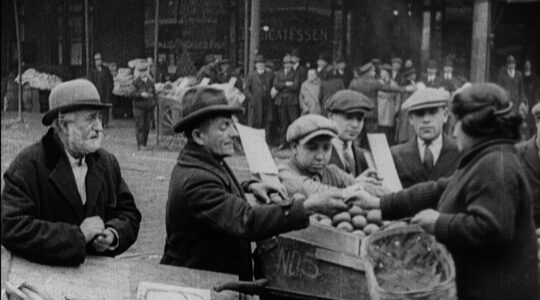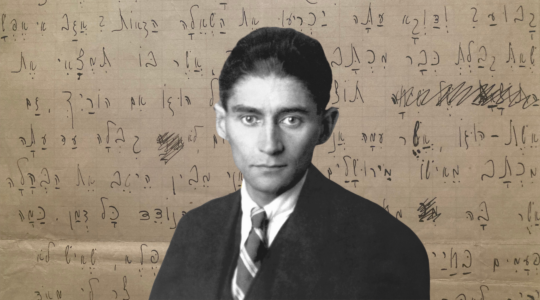Two rabbis, one Orthodox, one Reform, recently cancelled a speaking tour because some Orthodox authorities felt it inappropriate to share a stage, and imply common virtue, with a Jew with whom they disagreed. We are a people at war with the world and with each other. We have uniforms to prove it. If Americans have taken to wearing flags in times of crisis, some Jews have been turning their whole wardrobe into a flag, with styles not only intent at affirming our religious alliances but with the effect of exposing the aliens among us, even other Orthodox Jews, who donít know our rules. Weíre so highly stylized that an entire wing of Judaism is known by a hat and a color.
Jenna Weissman Joselit, author of
ìA Perfect Fit: Clothes, Character and the Promise of America,î describes a phenomenon thatís true for all conservative cultures, such as our religious one, in which the appeal of fashion is the opposite of its appeal in a more liberal society. In religious culture, beauty happily plays within strict rules: fashion is more about fitting in than standing out; more about restraint than allure; more about discipline than desire.
All this comes with the conceit that this is more about tradition than about an authoritarian trend. But how traditional is any of this?
Conventional wisdom says black was the color of our martyrís suits and fedoras before the Shoah. But Rabbi Berel Wein, an Orthodox historian and lecturer, says he couldnít help noticing something, a few months ago, while watching home movies taken in 1932. The film was from Ponovezh, Lithuania, a town ó and today, its eponymous yeshiva in Israel ó synonymous with black-clad Orthodoxy. Yet in the film, says Wein, the yeshiva students, though poor, were dressed as ìdandiesî wearing ìwhite or gray hats, ill-fitting light-colored suits,î and they even had ìcanes for strolling. Nary a black hat appears,î except for one on a rabbiís head.
Rabbi Wein, a columnist for the Jerusalem Post, tells us via e-mail that in pre-war Lithuanian yeshivot ó even in Ponovezh ó ìit became a sign of modernity,î and an acceptable one at that, ìto wear lighter colored clothing.î He adds that in Israel, the Yerushalmi ìold-time Jews,î not from Europe, ìstill wear light colored garments,î gold or white, ìas their Sabbath clothing. These are copies of [the clothing of] Turkish nobility in the 18th century,î much as chasidic fur hats evoke European nobility.
The ubiquitous black fedora, with brims wider than a Galician raptor, is a fashion bow to American nobility, says Rabbi Avi Shafran, director of public affairs for Agudath Israel. ìIn the 20th century, fedoras were worn by respectable businessmen and political leaders. They donít wear them anymore, but we havenít taken ours off because once we latch onto something it takes on a life of its own.î
Even in Modern Orthodox circles, dress is far from casual. At Manhattanís Jewish Center, with its German-British influence, Rabbi Ari Berman says synagogue officers ìare required on Shabbos morning to wear top hats and morning suits ó black formal jacket, vest, striped gray pants, with a dark or gray tie.î The rabbi wears a plain black suit, but a top hat just the same. ìAt the Jewish Center,î says Rabbi Berman, ìyou canít get an aliyah without a tie.î
Rabbi Berman admits, ìAt my Israeli yeshiva we didnít wear jackets or ties. I went straight from that to the Jewish Center, but I like it. It gives a sense of dignity and decorum, it distinguishes us.î The rules, he adds, are not by rabbinic fiat but the desire of the congregation.î
In the many Carlebach minyans sweeping the country, there is a tendency to dress informally, as did Shlomo Carlebach, the mystical troubadour. But for Reb Shlomo, the act of not wearing a tie was seriously thought out, a mystical choice. Reb Shlomo often cited a teaching on ties by the Piacezner rebbe. The Piacezner would wear a gartle sash around his waist while davening, as do many Orthodox Jews, in order to separate the lower body, seen as coarse, from the more cerebral and emotional characteristics associated with the upper body. A tie around the neck, the Piacezner told his chasidim, serves as a gartle cutting off the heart from the brainónecessary in business, maybe, but no way to dress for davening.
Elli Kranzler, cantor at the Hebrew Institute of Riverdale, and a practicing psychiatrist and teacher at Columbia University, says, ìWe are all wearing costumes and masks that communicate, consciously or not, an intention.
ìFormal clergy costumes and an on-stage frontal presence is intended to inspire respect and awe, but it also creates distance. It reflects the goal of performance rather than engagement.î For that reason, Kranzler chooses not wear a tie when serving as cantor. ìThe informal, open collar, for me suggests the message, ëOpen up! Loosen up! Because if you remain all bound up, you will never be free to make contact, to connect.í Itís what Iím trying to do when I daven and itís what I hope to communicate.î
Women have their religious fashions, as well. Rabbi Shafran is among those who noticed that Friday nights are finding more Orthodox women in ìShabbos robes,î loose fitting gowns, thoroughly modest, with sleeves down to the wrist and hemmed at the ankles. Beverly Luchfeld, president of the Long Island City-based Raza Designs that has been making these robes since 1994, believes the they were a pre-war Hungarian tradition, but Rabbi Wein said he was not aware of such robes before the war. Luchfeldís claim may simply be another example of Orthodoxyís ongoing sartorial sÈance, a sweet yearning to believe that weíre not quite the orphans that the Shoah has made us, that if we wear what the dead wore we are closer to them for having done so.
The robes are thriving for more practical reasons. Luchfeld says, ìWomen come to Shabbos table in whatever theyíre wearing because they rush home from work, shop, cook, dress the kids for shul, and are exhausted by the time they light candles.î The woman who makes Shabbos happen is the last for whom Shabbos happens. ìBut with a Shabbos robe, you just zipper it up and youíre dressed special for Shabbos. You want to relax. You want to be in a cuddly robe, cuddly and pretty.
ìWhatís more practical,î says Luchfeld, ìthan a Shabbos gown you can fall asleep in?î If you spill grape juice or soup, the robes are washable. Theyíre loose enough for pregnancies. Anything or nothing can be worn underneath, so theyíre fine for a bungalowís heat or Brooklynís chill. And you can strip in a zip.
Luchfeld, whoís Orthodox, is an award-winning designer who became aware of the Shabbos robe about 10 years ago. ìWhat was on the market,î said Luchfeld, ìwas too loose, too muu-muu.î She designed her own, using velvets, tapestries, knits, and microfibers, and now reports sales of 10,000 annually, with nearly 6,000 to Jewish women.
The robes are modest but yet sexy, wouldnít she say? ìYes,î says Luchfeld. In some chasidic neighborhoods, ìthey wonít wear my more fitted robes, or theyíll take a size bigger, so I suspect that they think it is too sexy. My robes look like you have a figure,î but not too much of a figure, and hey mister, what are you looking at, anyway?
Joselit, a professor of American studies at Princeton, tells The Jewish Week that ìthe Raza Shabbos robe strikes me as a female ó and unabashedly feminine ó analogue to the bekesha,î an ornate, sometimes satin formal Shabbos jacket for men. ìIt reflects the ongoing aestheticization of Jewish ritual, one of the great projects of modern Jewish culture, in that it attempts to render Shabbos dress ó as much as table appointments, cuisine or interior dÈcor ó visually pleasing to an increasingly well-heeled clientele. Perhaps what we have, then, is one of those fascinating cultural moments in which some American Jewish women have internalized notions of femininity and sexuality only to Judaize and render them acceptable, even laudatory, for an affluent, shomer Shabbat clientele.î
Orthodox fashions, at their best, celebrate Shabbat, a taste of the World to Come. But in the congregation of the sick and dying, who are actually on the verge of the World to Come, the politics of fashion falls further away. In hospital rooms, where they pray their evening prayers in garish light, everyone dresses the same: A green, short-sleeved gown, open in the back, tied in a drawstring at the nape of the neck. In Israel, where you can get to Heaven on a city bus, what do they wear? Near Bus 20, after it exploded, they found bloody rags that began the morning as school clothes. In Kibbutz Metzer, reports say Revital Ohayon was wearing pastels before bullets ripped through her and her two little children. They entered the Other World in their pajamas.
What are you wearing? In Heaven, as always, itís come as you are. n
Jonathan Markís e-mail address is jonathan@jewishweek.org
The New York Jewish Week brings you the stories behind the headlines, keeping you connected to Jewish life in New York. Help sustain the reporting you trust by donating today.




